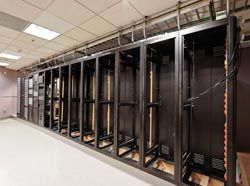The Oregon Convention Center in Portland recently upgraded to a new, advanced communications network from Biamp Systems, saving equipment, space, and money while improving overall performance.�PORTLAND, OR—The management at the Oregon Convention Center has developed a sustainable business strategy by embracing the latest technologies, including everything from renewable energy to a digital audio infrastructure to service its clients. In addition to increasing the amount of renewable energy purchased through Pacific Power’s Blue Sky program, OCC has also embraced the latest digital audio platform to meet current and future demands from increasingly sophisticated clientele.
The Oregon Convention Center is the largest convention center in the Pacific Northwest, designed for conventions, industry tradeshows, meetings, and banquets. Located in downtown Portland, OR, the OCC’s two grand ballrooms, 50 meeting rooms, one million square feet, including 255,000 square feet of exhibit space, can handle events from 10 to 10,000 people. However, its audio systems were a jumble of out-of-date products, decaying cables, aging patch bays, and other obsolete equipment in combination with some newer gear that was the result of a recent addition.
These two sectors are known as the Oregon side and Portland side, with Oregon being the original building. The newer Portland side housed newer equipment, circa 2002, and the mandate was to bring the older side up to par. When management asked Beaverton-based CompView to serve as the integrators for a completely new system, they insisted that no portion could be shut down. The CompView team likened it to open heart surgery.

- “We couldn’t take anything off-line because it’s going 24/7,” said Eric Boyd, project manager at CompView. “So the old one had to be up and running while we installed the new technology and bring it online without affecting their business.”
- The team even had to oversee the contractors who pulled the old cable to make sure the sections being pulled corresponded to the areas where new digital cable was already in place. That was just the cabling. The heart of the system had to provide deep levels of programming while still offering easy-to-use functionality, seamless audio distribution, and real time feedback for the operators. The Biamp AudiaFLEX with CobraNet capability was chosen as the foundation for the system. The AudiaFLEX chassis have AuidiaEXPI input expanders and AudiaEXPO output expanders to handle the large number of CobraNet channels in operation.
- Loudspeakers are JBL Control Contractor Series in the meeting rooms and ballrooms and Community Professional loudspeakers in the exhibit halls. Video sources brought in by clients can be plugged in and routed through the different halls with the new fiber distribution infrastructure.
- Like most convention centers, the ballrooms and meeting rooms are large spaces that can be subdivided. In this application, the old equipment did not permit easy reconfiguration of the space during rapid changeover from one event to the next or on-the-fly improvisation.
- “Our solution for them,” Boyd explained, “was the AudiaFLEX with the DaVinci programming because it is powerful and allows quick and easy setup, combining of rooms, and remote control of all parameters because it operates over the CobraNet network. Also, DaVinci lets us take analog signals and converts them so they can be programmed and routed according to client need.”
- One unique provision the AudiaFLEX allowed CompView to create was what they call “CobraNet boxes.” These boxes include an 8x8 AudiaFLEX chassis wired to an external patchbay, and are put on carts and wheeled around the facility as needs arise. A built-in laptop on a custom shelf with shock padding provides control so that they can roll it into a room, plug into the network jack and log on. The system can then take microphone feeds or amplifier feeds and route them through the network to any part of the facility, making any room with a CobraNet Box a broadcast facility and paging station. In all, there are 18 of these systems.
- Extending the system’s capabilities are three Sony Vaio wireless handhelds that allow operators to access any input or output in the system. This allows operators to respond to a call, for example, from across the convention center, which asks for re-routing of a signal or for a certain area to come online. This is different from the CobraNet Box, which serves more as a standalone mix position. Control is further expanded by the use of desktop computers in offices and other locations.
- Of course, having worked mostly with older technology, the facility’s staff took time to get used to a completely new way of operating. They were accustomed to twisting knobs and a lot of physical patching with no flexibility and limited parameters. Indeed, some of the previous equipment was more than 15 years old. They now live in a completely digital realm with everything configurable through the DaVinci software.
- Now, along with a large capacity for renewable energy, the Oregon Convention Center has an infinitely renewable audio system that provides a powerful resource for any future event.










